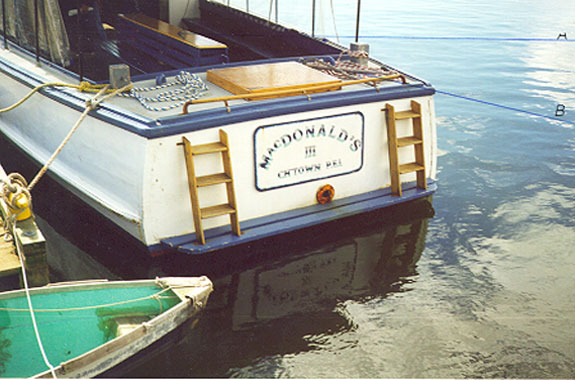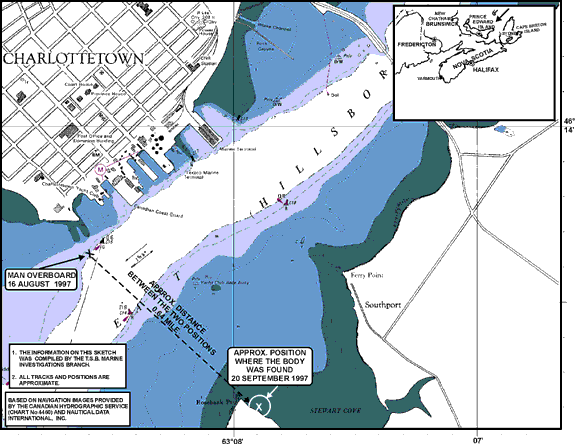Man Overboard from the small passenger vessel "MACDONALD'S III"
Charlottetown harbour, Prince Edward Island
The Transportation Safety Board of Canada (TSB) investigated this occurrence for the purpose of advancing transportation safety. It is not the function of the Board to assign fault or determine civil or criminal liability. This report is not created for use in the context of legal, disciplinary or other proceedings. See Ownership and use of content. Masculine pronouns and position titles may be used to signify all genders to comply with the Canadian Transportation Accident Investigation and Safety Board Act (S.C. 1989, c. 3).
Summary
The "MACDONALD'S III" was engaged in a pleasure cruise in Charlottetown harbour with 34 passengers and a crew of 3. One of the male passengers fell into the water. Despite rescue attempts by the "MACDONALD'S III", the man was not found. His body was recovered on the southeast side of Charlottetown harbour on 20 September 1997.
Ce rapport est également disponible en français.
Factual information
| Name: | "MACDONALD'S III" |
|---|---|
| Port of Registry: | Charlottetown, P.E.I. |
| Flag: | Canada |
| Official Number: | 328781 |
| Type: | Small wooden passenger vessel of Cape Island design |
| Gross tonnage: | 22 |
| Length: | 12 m |
| Crew: | 3 |
| Passengers: | 34 |
| Propulsion: | Ford diesel 2 x 135HP |
| Built: | 1967, Lower W. Pubnico, Nova Scotia |
| Owner: | Imperial Water Cruises, Charlottetown, P.E.I. |
The vessel had been built to the Cape Island design, but had previously been used as a local inshore ferry. The vessel was licensed to carry a maximum of 40 passengers, with a crew of 3.
The vessel had been fitted with clear plastic blinds, which zippered together. The blinds were mounted on a sturdy metal frame to provide some protection on both sides of the well deck from wind and rain. The after end of the well deck has no such plastic blinds. Access to the short afterdeck from the well deck is thus a simple matter of stepping from the after thwart onto the afterdeck.
The life-saving equipment consisted of 44 lifejackets in a centre-line unidentified box on the well deck, and four life-buoys, one of which had an automatic light. There were also three self-inflating life-rafts, stowed above the wheel-house.
The Safety Inspection Certificate, SIC 16, was issued by Transport Canada, Charlottetown, P.E.I., on 27 May 1997 and was valid until 30 September 1997. This certificate was valid for voyages in Charlottetown harbour and approaches, in fine weather and not more than five miles from shore. The vessel struck an underwater pillar in Charlottetown harbour on 17 September 1997 and was subsequently declared to be a constructive total loss.
Because of her age, "MACDONALD'S III" was "grandfathered" in that she was not obliged to submit to, nor to comply with, stability criteria, either with or without passengers on board.
The skipper stated that man-overboard situations had been discussed with the crew, but no drills for such situations had ever been performed.
To operate as a passenger ship, a vessel must be surveyed, licensed and have appropriate certificates. However, it is also possible to operate a vessel on a charter basis whereby the vessel is hired by an individual, or a company, for the purpose of entertaining friends, clients or associates. In this case, by definition, the people on board are not passengers.
Most operators of charter boats have their vessels inspected to a standard that permits Transport Canada to issue a Small Passenger Vessel certificate. This procedure then gives the operator the flexibility to take groups of fare-paying individuals on sight-seeing or fishing trips.
These small passenger vessels usually have little difficulty in obtaining a licence to sell alcoholic beverages on board. Due to a shortage of space on this vessel, the bar is normally set-up in the wheel-house. This arrangement was the case on the evening of 16 August 1997, where drinks were paid for by the charterer.
In Charlottetown and in other PEI ports in general where such vessels operate, they are generally referred to as the "booze boats".
By verbal agreement, "MACDONALD'S III" had been chartered by the owner of a company for the benefit of his staff. The duration of the charter, price, and complimentary drinks had been agreed between the company owner and the vessel owner.
Between 1900 and 1915 on August 16, the company owner and 32 of his staff boarded the vessel.Footnote 1 No crew member greeted them nor was any announcement made on the public address system regarding the stowage and use of safety equipment.
There were no placards posted to illustrate the correct way of donning and securing a lifejacket and giving the location and boarding procedures for the inflatable life-rafts.
The vessel departed Charlottetown Marine Terminal at approximately 1915, with the passengers sitting around the well deck. They visited the bar and the only toilet in the forward cabin (cuddy), access to which was made via the wheel-house.
At approximately 2045, while off the Charlottetown Yacht Club, the skipper noticed a passenger stumbling and ordered the bartender to stop serving him. The charterer suggested that rather than have his bar-service stopped entirely, he should be allowed to have coke with no rum. By that time this man had been served 3 double rum-and-cokes in approximately 40 to 45 minutes. He was also told to sit down in the well deck, where bench seating was arranged longitudinally on both sides and athwartships at the after end. The skipper also asked other passengers to watch out for him. But 10 to 15 minutes later, this man fell and the skipper heard shouts of "man overboard".
Observers confirmed that the missing man first climbed onto the port side of the after deck and started dancing (described colloquially as "jigging"). Passengers in the vicinity tried to persuade this man to come back down onto the well deck. Instead of returning, he moved over to the starboard quarter, where an anchor and a coil of rope were stowed on the deck. He resumed jigging despite the requests from other passengers to come back to the well deck. He fell overboard shortly thereafter.
The skipper ordered the mate, who was steering, to go hard to port and contact Coast Guard Radio by Very High Frequency Radio Telephone (R/T). He told him to advise them of the situation while he himself ran aft for a life-buoy, scanning the water-surface for the man in the water as he did so.
Shortly thereafter, one of the passengers, a strong swimmer, dove into the water. A life-buoy was thrown to this would-be rescuer and he was seen to get into it.
The charterer advised the skipper that the first man was just behind a sailboat approximately 50 feet (15 m) behind "MACDONALD'S III". The charterer then removed some clothing, jumped into the water and started swimming towards the area where the first man had been sighted.
According to those who knew him, the man who had fallen overboard was a good swimmer. When floating in the water, he showed no signs of distress such as waving his arms or calling for help. Reportedly he was in sight for approximately 30 to 60 seconds.
The surface water temperature in Charlottetown Harbour on August 16 was approximately 12° to 14°C. Canadian Red Cross information indicates that a person may survive for approximately 4 hours in such a water temperature.
Despite the best efforts of the skipper and crew and the many persons on board keeping a lookout, the man who had fallen overboard was not seen again. The search was further hampered by the failure of the vessel's searchlight.
The first would-be rescuer was picked up from the water still holding on to the life-buoy. The charterer was picked up from a sailboat moored off Charlottetown Yacht Club.
Despite an area search by "MACDONALD'S III", other local vessels, an aircraft, an RCMP dive-team and beach searchers, the man who had fallen overboard was not found. His body was found on the southeast side of Charlottetown harbour on 20 September 1997.
Analysis
The inspection certificate (SIC 16) issued by Transport Canada lists the safety equipment to be carried on the vessel. The equipment includes 3 inflatable life-rafts capable of accommodating a total of 45 persons, 4 life-buoys, and 44 lifejackets.
The lifejackets were stowed in an unidentified box in the well deck. There were no placards posted indicating the correct method of wearing and securing a lifejacket. There was also no announcement or demonstration made by any members of the crew regarding the safety equipment when the passengers boarded.
The owner and skipper of the vessel had no man-overboard procedure in place. The topic had been discussed between the skipper and the crew but no practice had been carried out. Such a demonstration is not required by Transport Canada, nor is the practical use of inflatable life-rafts or life-buoys.
The TSB issued a report, number M95M0092, after "MACDONALD'S III" grounded near Charlottetown Harbour in 1995 with 15 passengers on board. The cause was assessed to be the result of the close proximity of the bar in the wheel-house and the proximity of many non-essential persons at the navigation position.
It is unknown whether the man who fell overboard had consumed alcohol before boarding the vessel. However it was confirmed that he had consumed three double rum-and-cokes in a 40- to 45-minute-period on board. His behaviour, before falling overboard, was such that the skipper instructed the bartender not to give him any more alcohol. That action had been already implemented by the bartender, who had also observed his unsteady behaviour.
The actions of the two would-be rescuers, while commendable, placed a further burden on the skipper who, instead of having a man-overboard situation to deal with, now had three men in the water.
The man who had fallen overboard, although he had been sighted in the water for approximately 30 to 60 seconds, was lost to sight.
Findings
- The passengers boarded the vessel without any contact with the crew of "MACDONALD'S III".
- The passengers were not provided with any information regarding the stowage of the inflatable life-rafts, life-buoys, lifejackets or fire-fighting equipment.
- There were no notices posted regarding the use of safety equipment.
- There had been no man-overboard practices carried out.
- The number of non-essential persons in the comparatively confined area of the wheel-house was distracting to the skipper and crew.
- Prior to his falling overboard, fellow passengers tried unsuccessfully to persuade the man to remain in his seat on the well deck.
Causes and Contributing Factors
The man who fell overboard did so because he left the security of other areas of the vessel and recklessly danced on the narrow, cluttered area of the afterdeck.
The consumption of alcohol may have been a contributory factor in promoting irresponsible behaviour and a disregard for potential dangers.
This report concludes the Transportation Safety Board's investigation into this occurrence. Consequently, the Board, consisting of Chairperson Benoît Bouchard, and members Maurice Harquail, Charles Simpson and W.A. Tadros, authorized the release of this report on .


